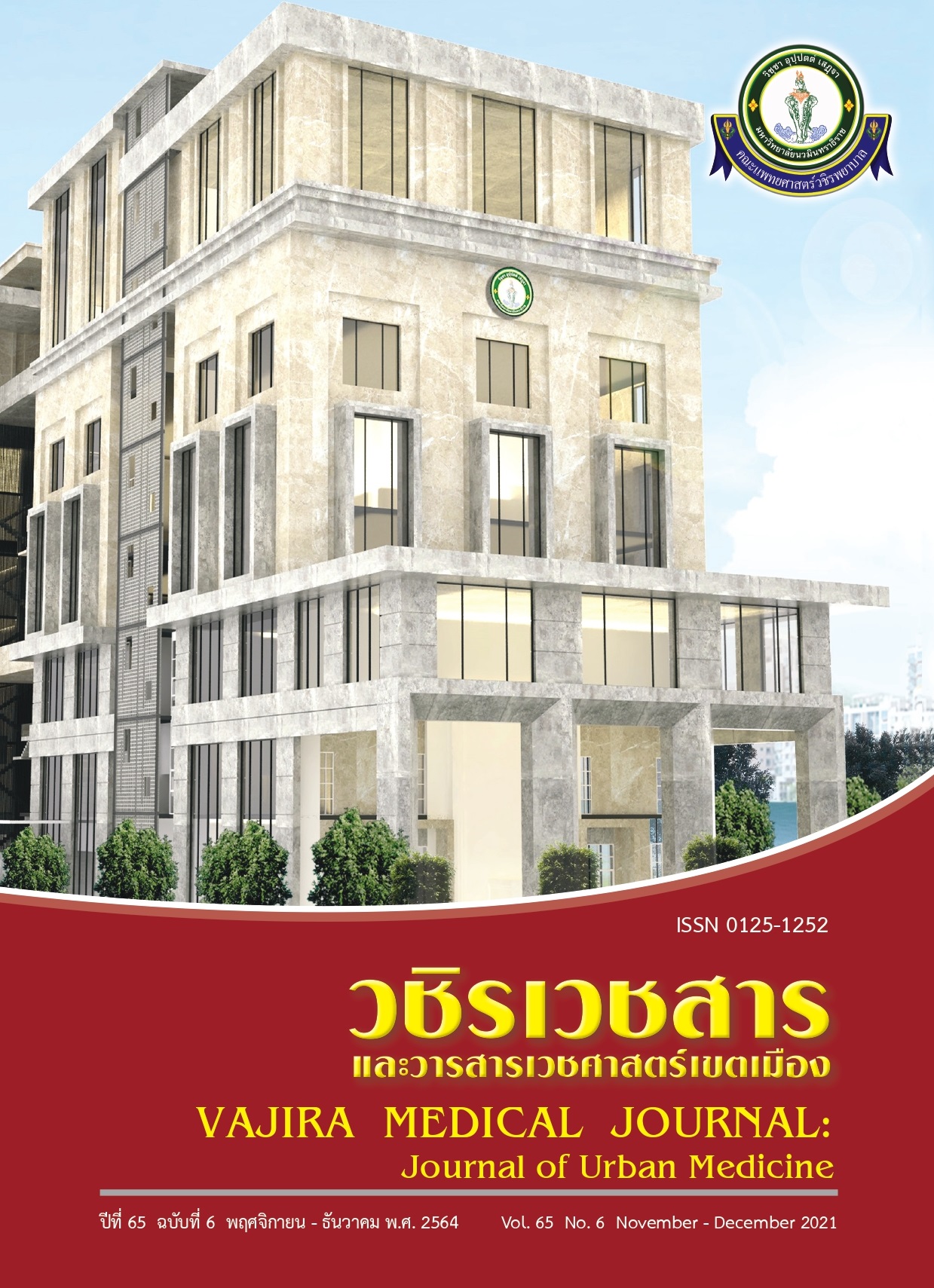Risk Factors Associated with Birth Asphyxia of Neonate at Faculty of Medicine, Vajira Hospital
Main Article Content
Abstract
Objective: To determine risk factors associated with birth asphyxia in pregnancies.
Methods: A case control study was conducted by including 578 newborns delivered at Vajira Hospital between January 2018 and March 2020. Cases were 289 women who delivered the baby with Apgar score ≤ 7 at 1 minute, while the controls were 289 women who delivered the baby with Apgar score > 7 at 1 minute. The data was collected from medical records. Antepartum factors, intrapartum factors and newborn factors were analyzed with univariate analysis and binary logistic regression analysis.
Results: Factors significantly associated with birth asphyxia included breech presentation (OR 3.18, 95% CI 1.10-9.22), vacuum extraction (OR 10.06, 95% CI 2.00-50.45), cesarean section (OR 2.53, 95% CI 1.59-4.03), preterm delivery (OR 6.62, 95% CI 3.26-13.46) and birthweight < 2500 grams (OR 3.49, 95% CI 1.54-7.90).
Conclusion: The statistically significant risk factors associated with birth asphyxia were breech presentation, vacuum extraction, cesarean section, preterm delivery and birthweight < 2500 grams.
Downloads
Article Details
References
Bryce J, Boschi-Pinto C, Shibuya K, Black RE. WHO estimates of the causes of death in children. Lancet 2005;365(9465):1147–52.
Golubnitschaja O, Yeghiazaryan K, Cebioglu M, Morelli M, Herrera-Marschitz M. Birth asphyxia as the major complication in newborns: moving towards improved individual outcomes by prediction, targeted prevention and tailored medical care. EPMA J 2011;2(2):197–210.
World Health Organization. International statistical classification of diseases and related health problems -10th revision. 2nd. Geneva:WHO; 2010.
Pitsawong C, Panichkul P. Risk factors associated with birth asphyxia in Phramongkutklao Hospital. Thai J Obstet Gynaecol 2011;19(4):165–71.
Department of Health, Ministry of Public Health, Thailand. 2010 Annual report. Bangkok: Ministry of Public Health 2011:25-26.
Saksangawong S, Rattanamongkolgul S. Risk factor and risk score for birth asphyxia in Kumpawapi Hospital, Udonthani province. RTA Med J 2019;72:41-52.
Aslam HM, Saleem S, Afzal R, Iqbal U, Saleem SM, Shaikh MW, et al. Risk factors of birth asphyxia. Ital J Pediatr 2014;40:94.
Strategy and Planning Division, Ministry of Public Health, Thailand. Strategy and KPI in year 2016. Bangkok: Ministry of Public Health, Thailand 2015: 42-48.
Lee AC, Mullany LC, Tielsch JM, Katz J, Khatry SK, LeClerq SC, et al. Risk factors for neonatal mortality due to birth asphyxia in Southern Nepal: A prospective communitybased cohort study. Pediatrics 2008(5);121:1381-90.
Chen ZL, He RZ, Peng Q, Guo KY, Zhang YQ, Yuan HH, et al. Prenatal risk factors for neonatal asphyxia: how risk for each? Zhongguo Dang Dai Er Ke Za Zhi 2009(3);11:161-5.
Milsom I, Ladfors L, Thiringer K, Niklasson A, Odeback A, Thornberg. Influence of maternal, obstetric and fetal risk factors on the prevalence of birth asphyxia at term in a Swedish urban population. Acta Obstet Gynecol Scand 2002;81(10):909-17.
Panna S. Risk factors for birth asphyxia in newborns delivered at Nongkhai Hospital. Srinagarind Med J 2020;35(3):278-86.
Kolatat T, Vanpragar N, Thitadilok W. Perinatal asphyxia: multivariate analysis of risk factor. J Med assoc Thai 2000;83(9):1039-44.
Suwannachat B. Risk factors for birth asphyxia in Kalasin Hospital. Srinagarind Med J 2004;19(4):233-40.
Gunay T, Turgut A, Demircivi Bor E, Hocaoglu M. Comparison of maternal and fetal complications in pregnant women with breech presentation undergoing spontaneous or induced vaginal delivery, or cesarean delivery. Taiwan J of Obstet Gynecol 2020(3);59:392-7.
Bener A, Salameh KM, Yousafzai MT, Saleh NM. Pattern of maternal complications and low birth weight: Associated risk factors among highly endogamous women. ISRN Obstet Gynecol 2012;2012:540495. doi: 10.5402/2012/540495.


